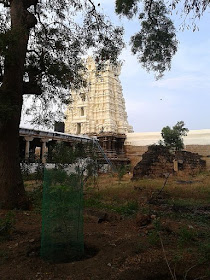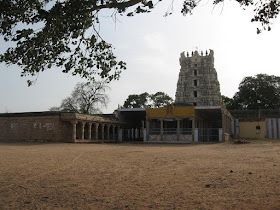Krishnapuram Venkatachalapathy Temple – The Temple
The
temple occupies an area of 1.8 acres (0.73 ha) and is surrounded by a
granite walls. The temple had originally three precincts, the outer one of
which was demolished by Chanda
Sahib at the orders
of Nawab of Arcot. The stones were used to build the fort at Palayamkottai.
The five tiered Rajagopuram, the temple's gateway tower, is 110 ft.
(34 m) tall. The sanctum houses the image of Venkatachalapathy in standing
posture 4 ft. (1.2 m) is made of granite sporting four arms. Two of
his arms hold the conch and Chakra, while the other two sport Abayamudra and Kadahasta.
The
images of Sridevi and Bhudevi are located on either of his side. The festive
image is called Srinivasan and the image has identical features as that of the
presiding deity. The Ardha mandapa is guarded by two Dwarapalas on either side. There is a separate shrine of
Alamelumangai in the third precinct, which also houses the festival image. There
is a Dwaja sthambam at the entrance of the precinct after crossing the
Rajagopuram and in front of it sits Garuda the vehicle of Lord Vishnu facing
the deity.
There are
lots of halls in the temple namely the Pandal Mandapam, Vahana Mandapam, Ranga Mandapam
and Nanguneri Jeeyar Mandapam. The Pandal Mandapam has pillars replete with
architectural features displaying pushpaboikai, palagai and varikolam. The
Unjal Mandapam is designed to accommodate the swing for the festival deities.
The square shaped Vasantha Mandapam has Navarang style.
The
Veerappa Nayaka Mandapam situated north of the temple has two
beautifully-carved elephants at its entrance. There are exquisite carvings in
the pillars and life size images indicating various legends of Hindu Puranas. The
six pillars at the mandapam exhibit `Puranic’ scenes with dexterity. Another
unique feature of the temple is the musical pillars that produce interesting
sound, when tapped. When a pin is dropped from the top of the bow, it reaches
the bottom and what is so special about it is that the bow is not straight but
bent. This stone carving too has been damaged as only a part of the bow is
seen.
The
Jeeyar Mandapam houses lots of pillars with images of ladies hold lamps as in
Kerala temples. The seer of temples used to rest at this place during
festivals. The Sorga Vasal (gateway to heaven) is located to the west of Yaagasaalai
Mandapam and is open only during the ten-day Vaikunta
Ekadasi festival. Manimandapam has numerous pillars
with sculptures of elephants and Yalis.
Krishnapuram
Venkatachalapathy temple is the alternative to those unable to visit Tirupathi
to fulfill their prayer commitments. Every statue and idol looks
alive and produces a bronze bell sound when tapped. Krishnapuram sculptures
are globally famous. Stones speak in this temple. Every
sculpture is a piece of wonder. This temple is an architectural marvel and each
sculpture looks fabulous and terrific.
There
are 42 sculptures, in all, at the temple, each of which just as stunning as the
others. The sculpture of the temple is globally famous. They produce a bronze
bell sound when tapped. The temple houses rare sculptures from the Nayak period
in the Veerappa Nayak Mandapam. Even the ornaments and clothes engraved on the
figurines are looking grand and awesome. This temple is a real heritage which
needs to be preserved for its art as it holds a charm of its own.
Manmatha and Rathi opposite to each other:
One
finds Rathi and Manmatha right opposite each other. Rathi’s hands are so
beautifully depicted that the veins on her left wrist are clearly seen, so much
so that one is tempted to actually feel the wrist to confirm if it’s only a
sculpture and not a living person. One look at the beetal chewing Rathi leaves
us with the same stunning feeling - For a minute, it seems that Rathi is
actually standing there in front of us – alive- and chewing the leaves, such is
the depiction. To her right, is a small bowl for her to spit the beetal leaves.
Opposite Rathi stands the 5 ½ feet Manmatha, with a bow in hand and truly
handsome – The craftsmanship is of the highest order that it brings the
sculpture to life.
Bheema, Vyakra Balaka (Shiva’s Devotees) and Dharma
Raja:
This is
a remarkable structure of three men all from one stone. This sculpture depicts
a fight between Bheema and Vyakra Balaka, with Dharma Raja presiding in to give
the decision in Vyakra’s favour. One finds Dharma Raja all in peace with
himself while Bheema is his arrogant self.
Lankan Connection:
The
depiction of a Queen with a 3 tier crown and dressed up beautifully, that is so
typical of Sri Lankan rulers, leaves one to wonder that there may have been
some Lankan connect, dating back to Ramayana, with this temple. But no data is
available to this effect.
Veera Bhadra:
Veera
Bhadra sporting a big moustache is seen looking down at the devotee. The veins
of the Lord can be seen clearly.
Ramba’s Beauty:
At the
entrance of the temple, on the right, is Ramba – depicted with a long sharp
nose and with big ear rings- something quite unique at TN temples. One can well
imagine her beauty from the depiction of Ramba at this temple.
Princely Karna:
A
Sculpture of Karna with a big bow in hand (now partly broken) and a princely
mustache. This takes us back to the days when Duryodhana crowned Karna the
Prince.
Arjuna’s Penance:
Right
next to the Princely Karna is a (long long) bearded Arjuna in deep penance. A
remarkable sight here is the long nail of Arjuna on his right hand (thumb)
showing his many years of penance.
An elephant and a Cow in the same image:
The
other fascinating sculpture here is that of two animals made out of one stone.
As one looks from the left, one sees an elephant lifting its tusk. From the other
side, though, this same image shows us a cow- truly a terrific piece of
art.
Queen on King’s Shoulder:
A king
lifts his queen on his shoulder as he fights off his enemies. The (heavy)
weight of his queen stretches the king and one sees the stretched muscles on
his right hand as well as the expanding ribs. The breeze lifts one part of the
Queen’s saree above her head, almost in a manner of protecting her from the
scorching heat.
King saving the abducted Prince:
Another
remarkable piece of architecture is that of a king who undertakes a chase on a
horse to get back his abducted prince. At the battle field, one finds the angry
horse leaping forward with its front legs off the ground and high in the air.
The king who is slightly unsighted is seen moving to his right to grab the
attention of the abductor- this is an unforgettable visual and a treat to
watch.
Other Sculptures:
The
female with a parrot on her shoulder and a beggar with a monkey on his shoulder
are too lively. Two lovers make love in another pillar, whereas a knight and
gypsy watching a dancing girl in another pillar. There is another interesting
pillar where a lady is pulling the beard of a sage who is trying to molest her.
These
pieces of art leaves everyone rooted to this temple, at the same time wondering
why this has failed to draw devotees, despite this being right on the way to
the Nava Tirupathi Divya Desam. The other fact is that this Vishnu temple
is now being managed by a Saivite temple. Between 1975 and 1994, this temple
was under the administration of the Tirunelveli Nellaiyappar temple.
For the
last dozen years, this temple has been administered by the Tiruchendur temple
Management. The Krishnapuram Venkatachalapathy temple is popular among the
tourists not because of its religious importance but due to its life sized
beautiful sculptures and images. With respect to the beauty of sculptures,
Krishnapuram temple can be considered as one among the best in Tamilnadu
temples.























